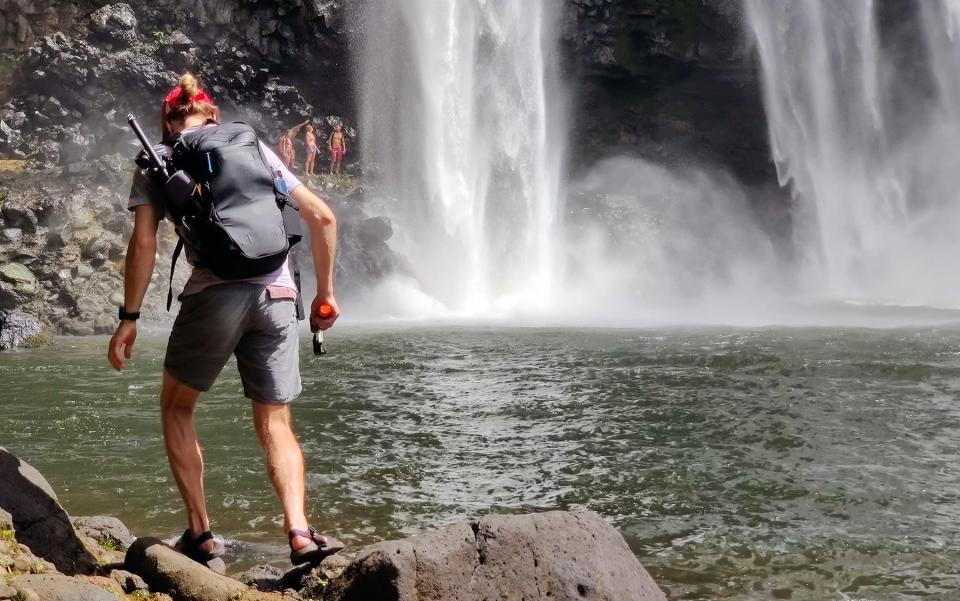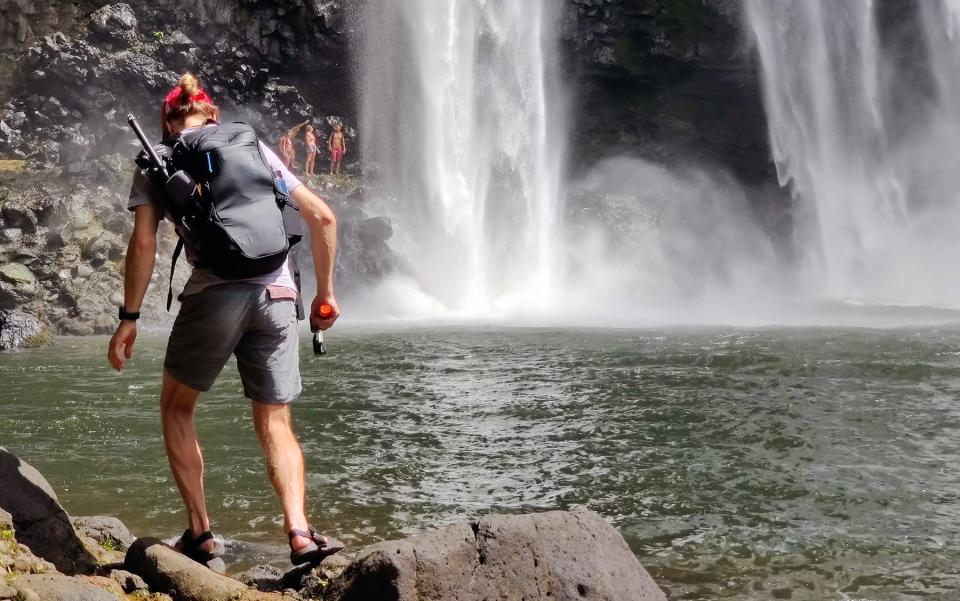Aspirational action: How GoPro makes you want a GoPro
Behind the scenes with GoPro's most important video of the year.
"We'll get about 10 feet from the beach, and it's an easy swim to the shore," the captain of our small boat chirps confidently. It looks more like 60 feet to me. My handler dives right in, so I flop belly-first behind her. I flail against the waves for what feels like a breathless eternity until I finally sense land underfoot. And then a wave crashes over me while the rest of the group -- all bronzed GoPro employees -- watch me get rolled over. And then a second one, until someone takes pity and peels me out of the shame-soup onto dry land. This is categorically not a GoPro moment, but it's about to be.
It's mid-July, and GoPro is shooting its promo for the Hero 8 Black camera that will launch a few months later (that's today). I was offered a behind-the-scenes look at how the company shoots its most important video of the year, the one it hopes will inspire millions of people to pay $399 for its latest and greatest device. All I had to do was get myself to Hawaii. No one mentioned anything about jumping off a boat.
The video I'm here to watch being made is a bit of a tradition. It's a few minutes of feel-good vibes that sells you a lifestyle as much as it does a camera -- and each year many look forward to it. And it's no small task to make it. GoPro's media team will travel to 25 beautiful locations around the globe over the entire project. That number expands to 75 if you include all the footage shot by sponsored athletes. All of that is then sifted through and condensed into the few pulse-raising minutes you see above.
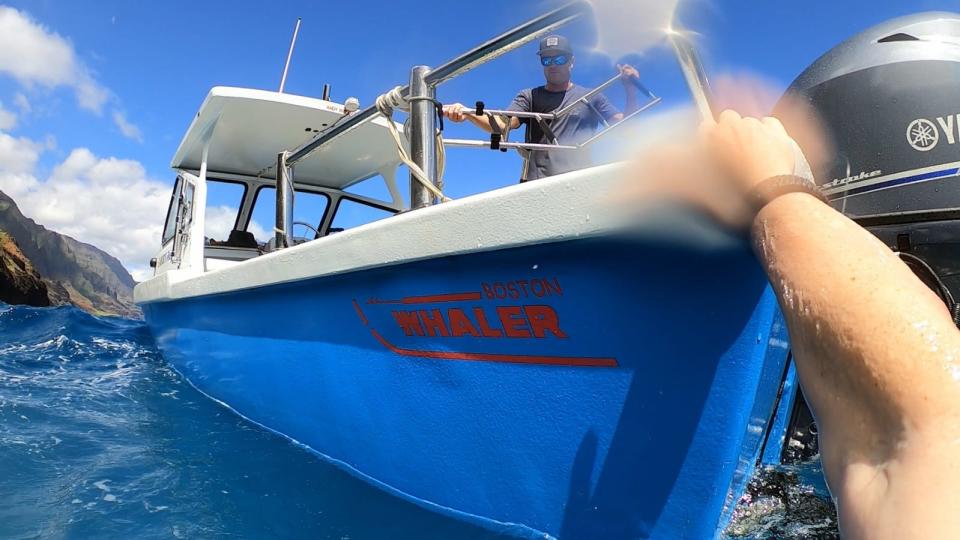
GoPro's Hawaii crew is made up of five members of the media-production team plus two athletes -- locals Nolan and Linda -- as on-screen talent. Then there's me, pale and out of shape, and my PR handler (and our optimistic boat captain). We only have two days with the media team, although this leg of the shoot will go on longer.
In fact, Hawaii is barely in the final video, comprising just a few seconds over three blink-and-you'll-miss-them scenes. Much of what was shot here will instead find its way into a variety of marketing materials. The amount of work and air miles that go into two short videos seem slightly less decadent once you know how much is repackaged and reused for various different promotional efforts.
In my mind, I would land in Hawaii and catch up with the media team on location. In reality, we arrive at roughly the same time, and within minutes I'm navigating a trail, wet from recent rain, with mud sucking the sandals off my feet. A few minutes and one broken flip-flop later, we reach a small clearing, there's a river with a rock protruding above it. Team GoPro instantly start doing flips off the ledge (with the new cameras of course). I'm already feeling the pressure to blend in, so perform a perfunctory "pencil" dive into the water. It's fun, but the resulting clip I record is barely worthy of my 400 Instagram followers. Team GoPro whoops in support anyway.
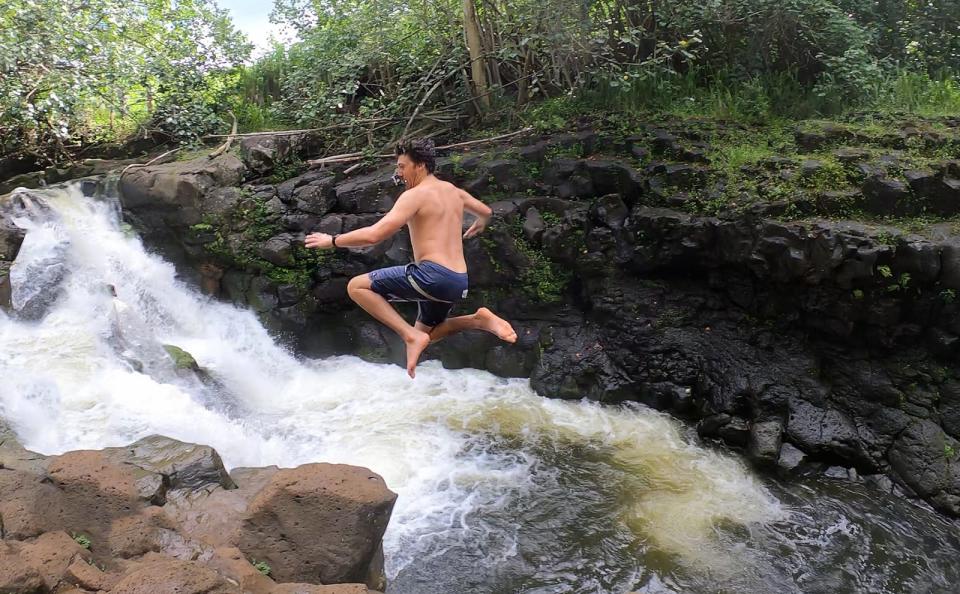
That beach I ungraciously washed up on is tucked away on an idyllic spit of Hawaii, accessible only by boat. You've seen these locations before, usually dripping in golden-hour wanderlust with beautiful people doing incredible things. What they don't show you is that, sometimes, a reporter is just off-camera nursing his ego while pretending to be a rock.
Why? Because on this shoot, the GoPro team are also recording with the new Max camera, and as it shoots in 360, everything gets in shot -- including the crew. So what do you do on an exposed beach to avoid being in the scene? We make like rocks (seriously). Yes, we literally curled up in the rocks and didn't move a muscle, though my white top might have been a bit of a giveaway.
There's less worry about the all the gear being in the shot, though, as the production team travels fairly light. As someone who has used GoPro cameras for several years, and not once even come close to producing something that would be worthy of a "sizzle" reel, I assumed GoPro used elaborate gear or staged environments. At least for the parts I saw, it was mostly a bag full of cameras, memory cards and a few selfie poles.
"Our full gear list mainly consists of just GoPro mounts. And then in terms of cameras usually I would say 20 is average, 40 high and 10 is low," Abe Kislevitz, GoPro's senior creative director, told me. "We usually have enough SD cards to last us two to three days of filming without having to swap out, so 60 SD cards. Batteries is usually on the order of 60 to 80."
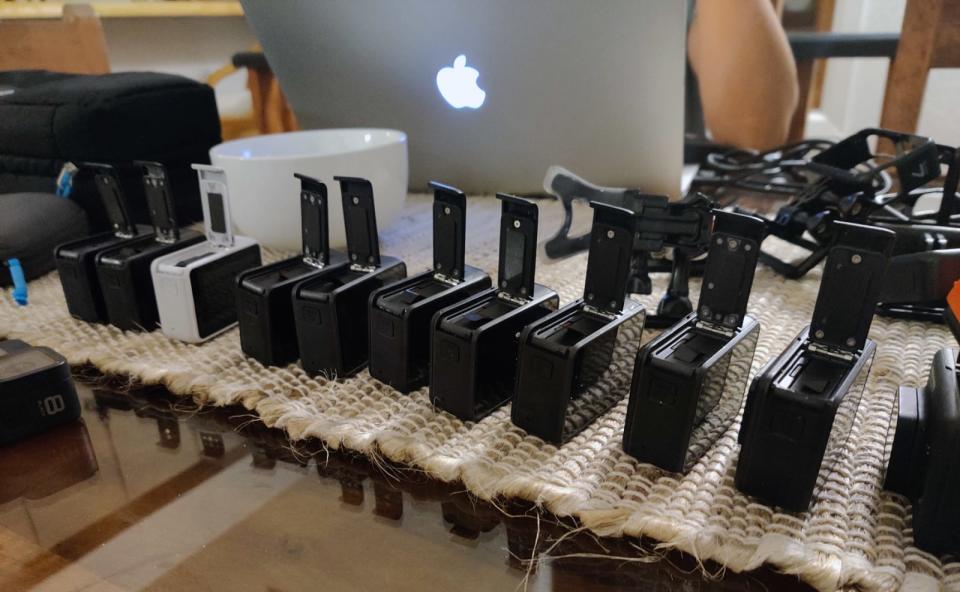
Before our journey out on the boat, we spent a morning at the base of a waterfall. To get there, the team slip past a sign saying "do not enter" before hiking down a well-trodden trail, where many other people (who had clearly also ignored the sign) are enjoying the misty spray and dream-like setting.
Party-pooper time: Some of the scenes in the video are staged (in case you thought they weren't). While we're at the waterfall, Nolan, Linda and one of the GoPro media team are directed to walk out to, under and back from the waterfall several times. Occasionally they are asked to pose, hands in the air as if they're having the time of their lives. Meanwhile, a Karma flies as near as it can without getting doused in the spray-off. Yep, the team still uses Karma -- which means some of the footage is shot with older GoPros, as the Hero 8 isn't compatible with the drone.
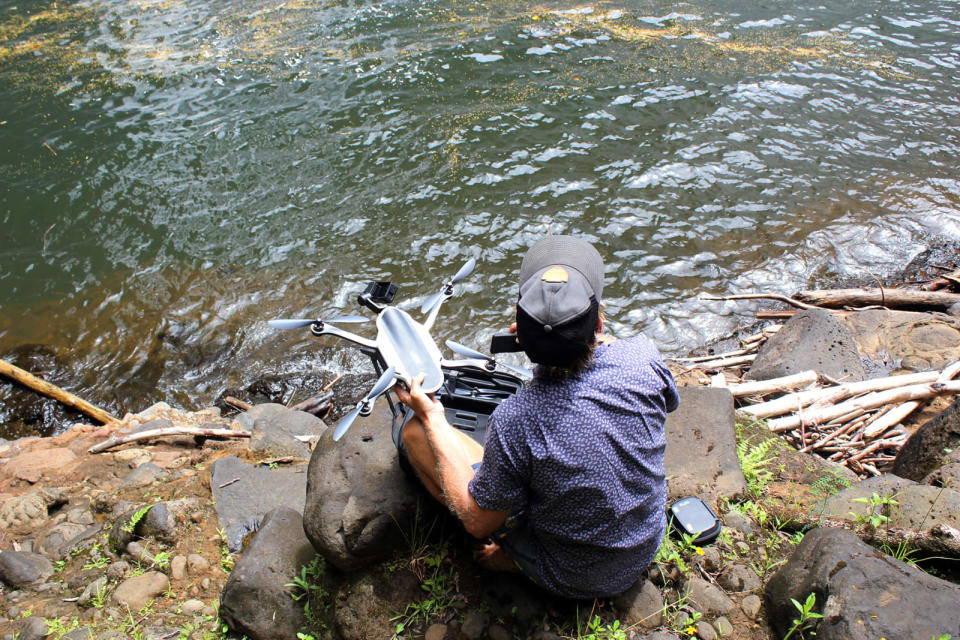
Nolan and Linda were found via the most fertile of GoPro breeding grounds: Instagram. One of the production crew had discovered Nolan's account and liked what he was doing. He mostly dives off the semi-shallow coast, navigating nooks on the seafloor, sharing moments with dolphins and turtles. He can also blow a mean bubble ring. The couple are quiet, shy almost, but also incredibly sweet. Oh, and annoyingly easy on the eye.
A post shared by Nolan Omura (@nolanomura) on Jul 18, 2019 at 5:34pm PDT
So sure, when you have a skilled media team; a bright, beautiful location; and a plan, your videos are going to look better than mine. Example: During some downtime on the water, we spotted a turtle. I dove in and swam almost directly above it (or so I thought) with a GoPro mounted on my goggles, thinking I am surely getting something worthy of Blue Planet 3. Turns out, in my haste, my camera wasn't angled properly, so I have a sweet video of its back feet.
Later, a pod of dolphins came right past our boat, so again, we jumped in. But when reviewing my footage, I was moving my head too quickly to really capture the pod in its full glory. Thus, location and a good camera are only half of the ingredients. After I climbed back in the boat, our captain decided that was a good time to point off to the horizon and tell me that's where pro surfer Bethany Hamilton's arm was bitten off by a shark. I never go back in the water again.
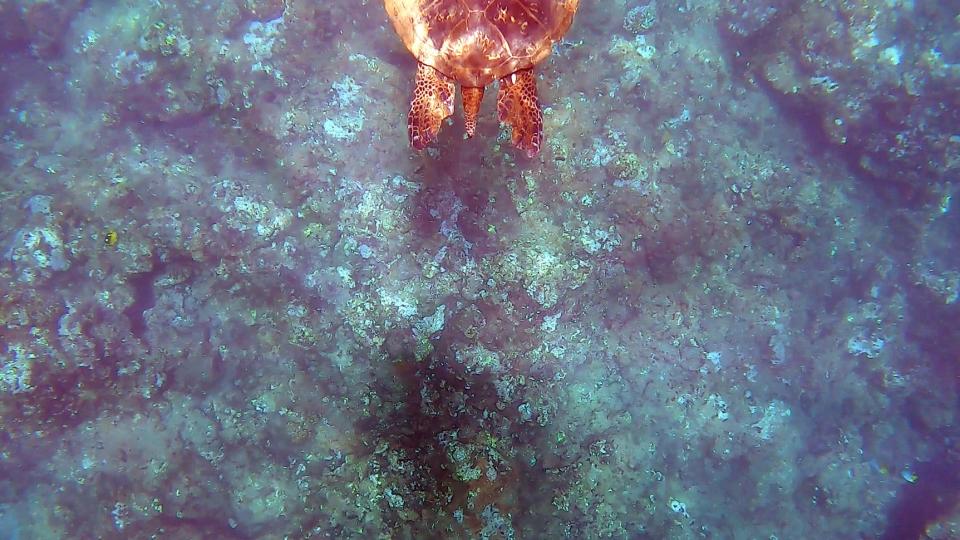
But let's imagine I had grabbed good footage. Surely GoPro's production goes through a heavy bout of editing and enhancement? According to Kislevitz, not as much as you think.
"We don't really do too much other than color correction. But with the Hero 8, we actually shot in the GoPro color [mode] because the color is really, really good." Kislevitz told me. "We shoot with low sharpening so that we can add our sharpening in post so that everything matches across the board." If the Hero 8's new HyperSmooth 2.0 needed a seal of approval, perhaps this is it? "We don't do any sort of stabilization on any of our clips. Everything is, thankfully, just stable out of the box. I haven't applied [Adobe Premiere's] warp stabilizer to a single clip in this video."
As much as the production is planned and as experienced as the team is, sometimes it's all about the happy accidents. After driving deep into the heart of the island, far from civilization, we reach a viewing point. Again, we shuffle behind a fence and past a "do not enter" sign and follow a trail to an exposed ridge. If there's one thing I have learned, it's that apparently this is where all the good locations are.
Nolan and Linda are sent out to the edge overlooking the valley and instructed to throw their hands in the air, holler with joy and so on. Again, a Karma buzzes around them. Then, out of nowhere, in this already paradisiacal location, a huge rainbow appears in the tropical mist to our right. It's fully golden hour, and I just can't even with how this all somehow seemed to come together.
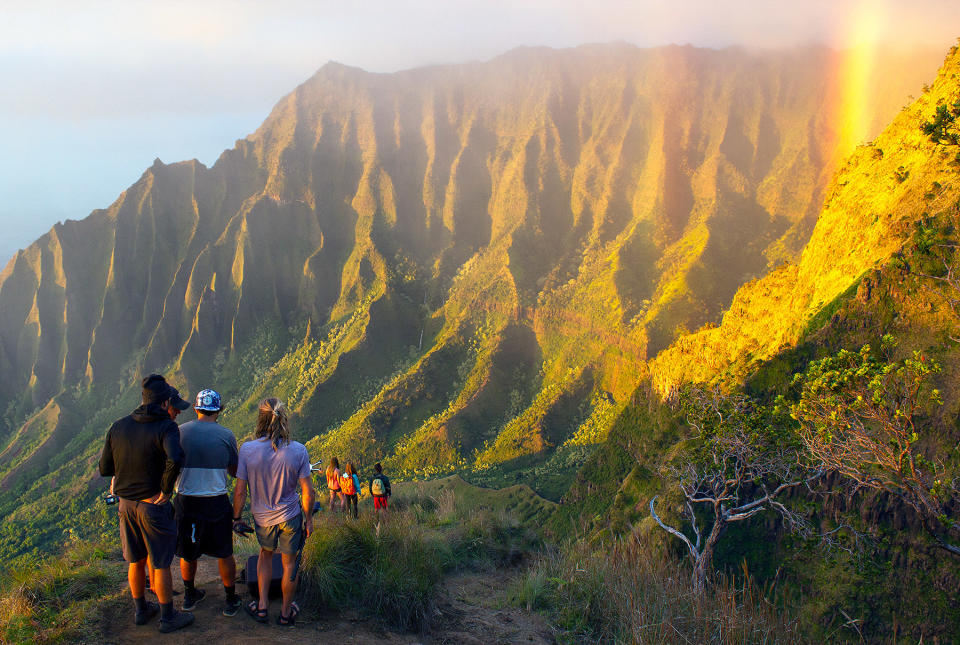
Kislevitz has seen it all before though. "I think you put yourself in the right place at the right time, and that location is going to look beautiful no matter what. But I think that, obviously, Hawaii is known for rainbows and clouds. That's why you pick the locations that you do," he nonchalantly told me. "You're planning the right places to capture the best sort of scenario possible. And so obviously you're superexcited when things line up and things work out. And sometimes they don't and sometimes they do, and just you're stoked about it."
Conversely, not all shoots go to plan. In the final video, you'll see someone flying with a jetpack. Turns out that the team went to Utah for a day's shoot, but due to weather and other problems, the pilot only managed two runs of about two minutes each. Just four minutes of video footage, yet there it is in the final cut, by the skin of its teeth -- and it's one of my favorite scenes.
Bagging all the footage is the fun part though. Putting it all together is the yeoman's work. For a video that's around two-and-a-half minutes long, it takes a huge number of hours to complete -- and there are no rocket men or rainbows to keep you going. Kislevitz told me it averages three to four weeks of 12 to 16 hour days. Three people are working on the edit, and maybe another three reviewing the footage, pulling "selects" (potential moments for inclusion). Every single frame of video that makes it to an SD card will be checked and scrutinized. Anything can happen in a second, so you don't want to miss it.
I get a hint of this on my last night. We're at the media team's shared AirBnB. Nolan and Linda are conked out in one of the bedrooms. Meanwhile, the GoPro team are gathering SD cards, charging batteries (lots of batteries) and moving media to backup drives (I was reassured to see they use the exact hard drive we recommend in our Outdoor's buyer's guide). Beers are being drunk -- it's a relaxed atmosphere, but definitely still work time.
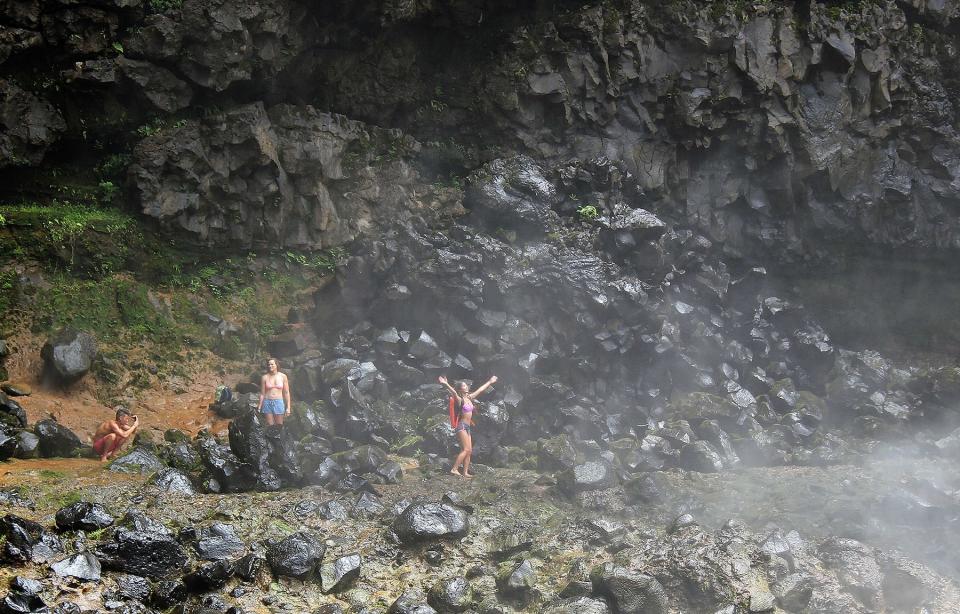
It's here that I realize the paradox. I have genuinely been surprised at how low key the whole shoot has been. Good locations, good light and a little bit of luck really seem to be the key ingredients. Yet there's still a large net being cast. Hours of footage that will find its way to the cutting-room floor. Piles of batteries and memory cards to make sure you don't miss a moment. Five warm bodies backing up material and planning for the next day's shoot.
I won't know what that next day involves, until weeks later when I am shown the final product. Linda can be seen posing on an outrigger. Ironically, all of the talent's appearances in the video seem to be in more of the candid moments, rather than the orchestrated "whooping" scenes. Perhaps those will be saved for the in-store point of sale displays or an online banner ad.
Either way, as of today, the new cameras are here and so are the videos promoting them. Despite a peek behind the scenes, I am still asking myself, "How did they get that shot?"

